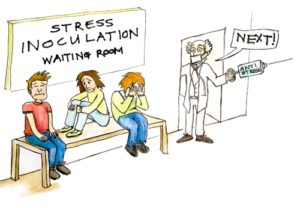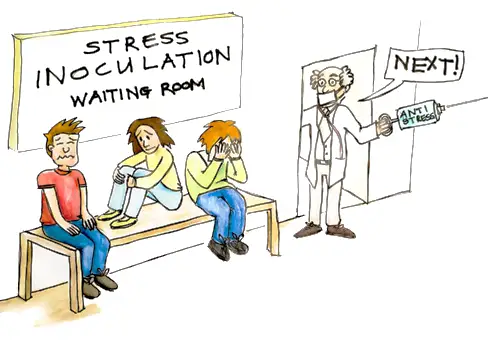Stress is an inevitable part of life. There are many ways to combat stress, but stress inoculation is one of the most effective. Stress inoculation can be defined as a process in which you prepare for future stressful events by experiencing them in a safe environment with trained experts. This blog post will explore what stress inoculation is, how it works and why you should try it!
Table of Contents
What is stress inoculation?
 Stress inoculation is a process in which you prepare for future stressful events by experiencing them in a safe environment with trained experts.
Stress inoculation is a process in which you prepare for future stressful events by experiencing them in a safe environment with trained experts.
Stress inoculation is a way of training your mind and body to respond effectively to stressful events. Research has shown that people who are trained in stress inoculation have higher levels of self-efficacy, which means they feel confident about their ability to succeed at challenging tasks.
How does stress inoculation work?
Under the supervision of experts, you will be exposed to a specific stressful event. You may experience a simulated fire, explore tense interpersonal situations, or be given specific math challenges or intense test anxiety.
You practice what you would do if the event occurred and learn ways of responding to it successfully. Exposing someone to the causes of their fear, anxiety or feelings of helplessness and providing instructions on how they can cope with these experiences will help them feel less anxious and more in control of the stress response.
Many techniques are available in stress inoculation, including instruction in a deep muscle relaxation exercise, relaxation techniques, cognitive restructuring, breathing exercises, assertiveness skills, pause for thought, guided self-discussion, and role-playing.
Who developed stress inoculation training?
Stress inoculation training was developed by Dr Donald Meichenbaum during the 1960s in response to the Vietnam War when he noticed many veterans were having panic attacks and anxiety reactions just from driving or being near other cars. He recognized that their posttraumatic stress disorder (PTSD) symptoms stemmed from traumatic incidents on the battlefield and everyday stress.
Stress inoculation is similar to medical immunization against diseases. We are all familiar with the concept of vaccination against diseases. This is when small doses of disease are given to an individual to make them immune or resistant to the disease. Similarly, stress inoculation is the process where we expose ourselves gradually and in manageable amounts to stressful situations so that they don’t overwhelm us when they occur later on.
Inoculation always consists of two parts: “the agent” (or what causes infection) and “the response” (how our body reacts). With medical inoculations, these agents may be viruses or bacteria prepared specifically for immunization purposes.
In contrast, with stress inoculations, agents might include difficult conversations at work or family conflict. The response to the agent can be measured by changes in heart rate, muscle tension or skin temperature.
That being said, exposure must be limited to manage stress levels appropriately. If you are exposed to stressors and get training on how to deal with them, you will be better able to handle future stressors.
People who use stress inoculation training report that it helps them approach complex tasks more calmly and better control their reactions to stressful events.
The main goal of this is to increase your capacity for coping with future stresses and reduce the amount of distress you experience during a given event.
There are no known negative effects from stress inoculation training.
What is stress inoculation training?
Stress inoculation training is a systematic process of preparing people for challenges they are likely to face that will help improve their coping skills when a stressful event occurs.
There are three phases: conceptualization, skill acquisition and rehearsal, and application and follow-through.
In the first phase, the conceptualization phase, the training provider educates their client about stress, establishes a collaborative relationship between provider and client, and assesses and conceptualizes the stressors the client faces.
A primary component of the second phase, the skill acquisition and rehearsal phase, is teaching and practising coping skills tailored to the client’s needs. These skills may include relaxation training, problem-solving training, cognitive restructuring, and positive self-statements.
During the final phase, application and follow-through phase, the client learns how to cope with real-life stressful situations through guided imagery and relapse prevention techniques.

What are Stress inoculation training steps?
The following seven objectives of SIT are essential as they provide the foundation for SIT. The trainer or therapist:
- Provides clients with specific information about the nature of stress and stress coping mechanisms.
- Teaches the clients to learn how to monitor their thoughts, feelings, images and behaviors. That way, they can think of better things instead of bad ones.
- Trains clients to identify problems, predict what will happen and plan how to fix the problem (Cognitive appraisal).
- Demonstrates to clients and practices coping strategies that rely on direct action, emotional regulation and self-control.
- Teaches clients how to use their maladaptive responses as learning tools to promote more productive ways of coping in situations they might otherwise find stressful.
- Provides training on in vitro visualization and behavioral rehearsal and in-person graded assignments to help foster client confidence in using their coping repertoire.
- Provides clients with adequate knowledge, understanding of themselves, and practical plans to enhance their coping skills as they deal with several unexpected, stressful situations and associated psychological reactions.
Stress inoculation training is an effective way of dealing with stressful events. It is also a helpful tool in coping with the everyday challenges and stresses that life presents. One study showed that after undergoing Stress Inoculation Training, the participants achieved higher levels of performance on a stressful task.
What is stress inoculation therapy?
Stress inoculation training entails teaching skills that can be applied in the face of stressful events in different situations, including high-stress jobs or sports. A range of professionals can implement stress inoculation training.
For instance, there are training programmes developed and implemented by managers, military personnel, etc. There are also physiotherapist-led stress inoculation training programmes for those that have survived severe injuries. However, only professionals trained in psychological interventions can deliver stress inoculation therapy.
On the other hand, stress inoculation therapy is a treatment for people who feel overwhelmed and need help coping with prolonged exposure to chronic stress, anxiety and PTSD symptoms.
Stress inoculation therapy is an evidence-based intervention that can help people become more resilient in the face of chronic stress or behavior disorders.
Stress inoculation therapy is a way to help those who have been exposed to trauma deal with future exposure, and it will also make them more resilient during times of hardship. It can be done on its own or alongside other types of therapy which are specific towards certain circumstances like depression or anxiety disorders.
Stress Inoculation Therapy has been proven to effectively reduce the impact of emotional distress by giving people an opportunity to mentally rehearse “what it will be like” to encounter a stressor, the so-called stress inoculation effect.
There are three different stages to this therapeutic modality: identifying, inoculating and reinforcing.
The first stage identifies these feelings that may arise when people experience a traumatic event or stressful situation. This will help them understand what they should do to feel less stressed out during future events.
The second stage involves being exposed to simulated trauma while having some sort of protection. A therapist present can advise on how best to deal with the distress. Simulating the experience without actually experiencing it first-hand can help the client apply the coping mechanisms beforehand before anything happens for real. In this instance, there’s often no physical danger but instead mental distress. The therapist may use relaxation techniques, visualization exercises or guided imagery to coach them through the experience with their input and feedback on what they think is best for them during that time of distress.
The third stage, called behavioral rehearsal, involves the client being exposed to short-term stressors while practising coping skills until those skills become automatic responses rather than deliberate choices. This helps reduce feelings of anxiety and fear because, by now, the client has a toolbox full of strategies at their disposal when it becomes necessary. Behavior rehearsal also prevents bad habits from developing by taking proactive measures against potential pitfalls before anything happens in real-life situations.
The benefits of stress inoculation therapy
Stress inoculation therapy is an effective treatment for people suffering from chronic stress. It teaches them better coping mechanisms and can help improve their performance in the face of stressful situations. This modality is also beneficial because it’s a more affordable form of therapy than traditional talk therapies like cognitive behavioral therapy, trauma-focused cognitive behaviour therapy and trauma-focused psychotherapy, which are often not covered by health insurance in the United States or have prohibitively expensive out-of-pocket costs.
Stress inoculation therapy can provide many other benefits. The first is that it teaches people how to recognize their stress warning signs and triggers and those of others around them. This will allow these individuals to take steps before the event occurs, so they can avoid being overwhelmed by the situation when it does happen.
One other benefit from this type of treatment is that it reduces anxiety symptoms such as sleeplessness or panic attacks caused by excessive worry during times where there has been no trigger previously exhibited over an extended period (which would have led one who was not undergoing stress inoculation training into developing posttraumatic stress disorder).
The third benefit from therapy sessions is that those in need will learn how to control these feelings through various techniques taught throughout the process.
These skills should be practised daily, so they become second nature at any point in time.
Developing this skill set will also allow the person to understand better and control their emotions, which is crucial in helping the person cope with stress before it becomes overwhelming and debilitating.
How is stress inoculation therapy different from exposure therapy?
Exposure therapy, or its variant, stress exposure training, is also a widespread treatment for anxiety. Exposure therapy, however, works on the idea that by gradually exposing someone to their triggers and building up a tolerance over time, they can eventually overcome them. This is done through gradual exposure to triggering situations which are often avoided or feared to condition the sufferer not to be afraid of them.
Exposure therapy is often used to treat acrophobia (fear of heights), claustrophobia and other specific phobias. It can also be a helpful tool for treating PTSD, panic disorder and obsessive-compulsive disorder (OCD). Exposure to triggers helps someone who suffers from anxiety understand that they are not in danger and to see that the object of their fear is not nearly as bad as they imagine it.
Exposure therapy helps patients face what scares them in a controlled environment with an accompanying therapist, progressing gradually from discussing fears or looking at photos into facing some form of exposure to whatever triggers anxiety, e.g., snakes – whether for someone who has claustrophobia, looking at a small enclosed space or being in one; for someone who has acrophobia – going up to the top of a building.
Exposure therapy is often used as an adjunct with cognitive-behavioral therapy (CBT) and exposure-based psychotherapy. CBT helps patients identify irrational thoughts and beliefs contributing to their fear and develop more realistic thoughts.
Exposure therapy is one of the most effective treatments for anxiety disorders, OCD (Obsessive-Compulsive Disorder), PTSD (Post Traumatic Stress Disorder) and other phobias. It should be used in conjunction with cognitive behavioral therapy or exposure-based psychotherapy to provide a comprehensive treatment plan.
In contrast, stress inoculation therapy does not require gradual exposure as it is meant for people who are already stressed out or suffering from anxiety-related issues.
Stress inoculation training has been used to prevent health problems, such as anxiety or depression. A therapist helps a person identify worries in their life that make them feel overwhelmed and be more prepared for these situations when they happen again.




